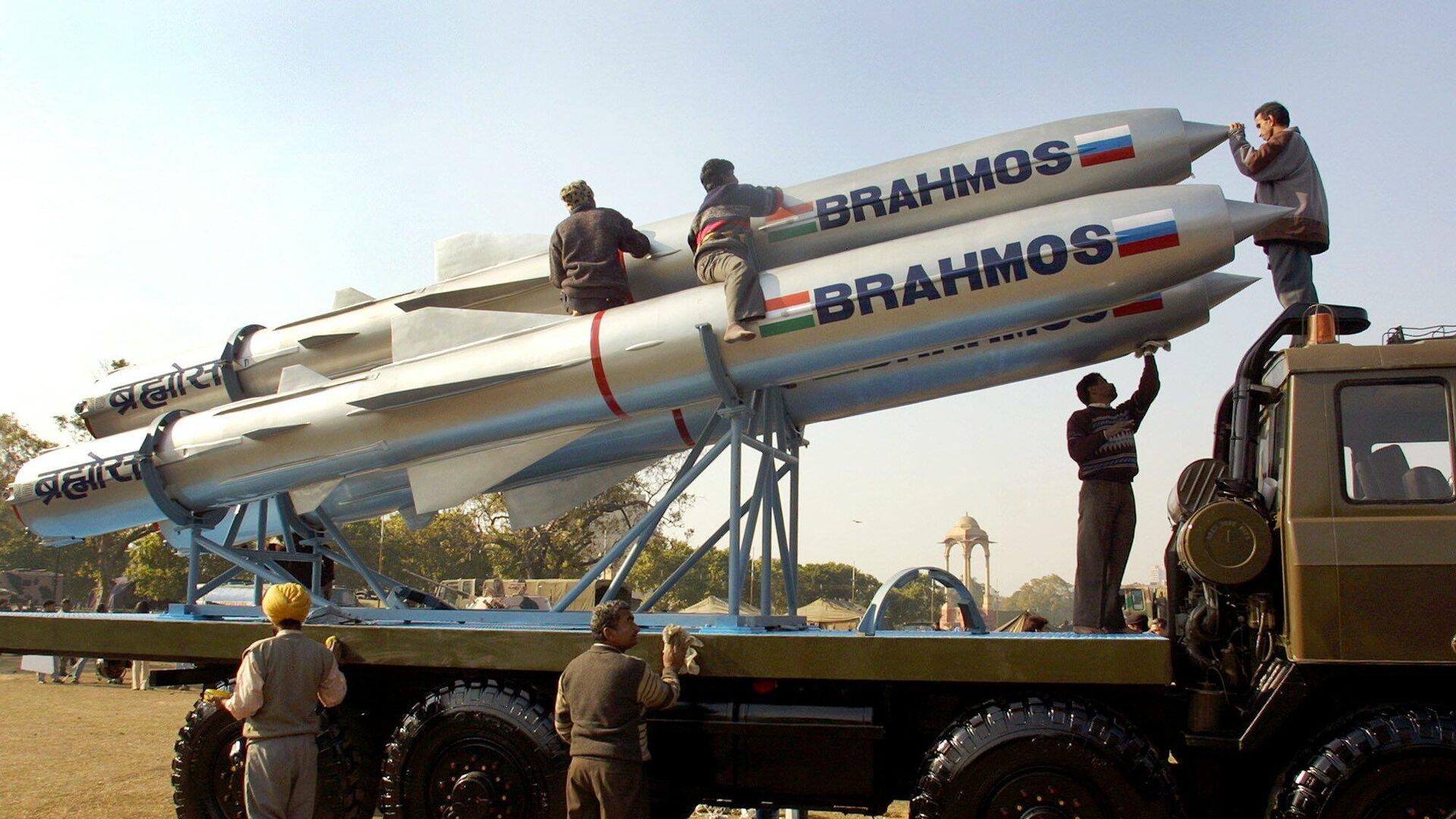https://sputniknews.in/20250522/brahmos-the-ultimate-winner-of-the-indo-pak-confrontation-9175151.html
BrahMos: The Ultimate Winner of the Indo-Pak Confrontation?
BrahMos: The Ultimate Winner of the Indo-Pak Confrontation?
Sputnik India
Union Home Minister Amit Shah confirmed that BrahMos missiles were used during Operation Sindoor to target terrorist infrastructure in Pakistan. 22.05.2025, Sputnik India
2025-05-22T20:40+0530
2025-05-22T20:40+0530
2025-05-22T20:52+0530
sputnik opinion
amit shah
narendra modi
india
pakistan
china
indian air force (iaf)
brahmos supersonic cruise missile
missile strike
missiles
https://cdn1.img.sputniknews.in/img/07e7/0a/0d/4808067_0:0:2000:1125_1920x0_80_0_0_5bfb5fc9f53c932cd5480674d1cc483d.jpg
In what is believed to be one of the first direct admissions by a Pakistani linked to the military, retired Air Marshal Masood Akhtar, a veteran of the Pakistan Air Force (PAF), confirmed in an interview with a local media outlet that the country's military infrastructure sustained significant damage following India’s precision strikes on nearly a dozen airbases during the night of May 9-10, knocking out radar sites and air defence platforms.Among the hardest hit was the Bholari airbase, with Akhtar corroborating that Pakistan lost one of its air defence systems there in what he said was a swift Indian Air Force (IAF) attack carried out through BrahMos missiles.The clip of Akhtar's remarks quickly went viral on social media, with military Open-Source Intelligence (OSINT) experts going as far as to say that Pakistan's air defences were not capable of handling the BrahMos missile.OSINT analyst Jaidev Jamwal even stressed that the IAF struck Pakistan's nuclear storage facility in Kirana Hills, a claim officially denied by India's Defence Forces.Jamwal backed his assertion on satellite imagery, which showed structural damage at the site. Notably, he suggested that India used a BrahMos missile to target this facility."A regular warhead would've exploded on surface causing a large crater and a lot of rubble. Here, the small hole indicates use of a earth penetrating warhead which penetrated a few meters before exploding. The size of crater will be small as the explosion & its effects will be felt underground. A BrahMos version was designed to hit targets on a vertical dive for targets like this," he added.It is worth highlighting that the Indian military hasn't publicly mentioned that BrahMos was put into service during its hostilities with Pakistan. However, India's Minister of Home Affairs, Amit Shah, did declare that BrahMos was used to cripple Pakistan's military assets during Operation Sindoor.Remarkably, India accidentally fired the BrahMos into Pakistan three years ago, but India's Western neighbour failed to intercept it, pointing towards a glaring gap in its air defences and vulnerability against the missile's precision, versatility, and lightning speed.Also, one should not forget that Operation Sindoor was the first battlefield demonstration of the widely acclaimed missile, considered to be the fastest supersonic weapon system on the planet, in which it came out victorious with flying colours, the IAF veteran elaborated.After decimating Pakistan's military facilities during Operation Sindoor, there's little doubt that the BrahMos missile has gained a cult status not only in India and Russia but also among nations that have been looking at a world-class weapons platform that comes at an affordable price compared to its Western counterparts, he explained.
https://sputniknews.in/20250521/operation-sindoor-bolsters-prestige-of-indias-defence-exports-9169958.html
india
pakistan
china
islamabad
Sputnik India
feedback.hindi@sputniknews.com
+74956456601
MIA „Rossiya Segodnya“
2025
Pawan Atri
https://cdn1.img.sputniknews.in/img/07e6/0c/13/139630_147:0:831:684_100x100_80_0_0_8fa2b25903e7787fe6a2698552c167df.png
Pawan Atri
https://cdn1.img.sputniknews.in/img/07e6/0c/13/139630_147:0:831:684_100x100_80_0_0_8fa2b25903e7787fe6a2698552c167df.png
News
en_IN
Sputnik India
feedback.hindi@sputniknews.com
+74956456601
MIA „Rossiya Segodnya“
Sputnik India
feedback.hindi@sputniknews.com
+74956456601
MIA „Rossiya Segodnya“
Pawan Atri
https://cdn1.img.sputniknews.in/img/07e6/0c/13/139630_147:0:831:684_100x100_80_0_0_8fa2b25903e7787fe6a2698552c167df.png
amit shah, narendra modi, india, pakistan, china, indian air force (iaf), brahmos supersonic cruise missile, missile strike, missiles, pakistan army, islamabad, operation sindoor
amit shah, narendra modi, india, pakistan, china, indian air force (iaf), brahmos supersonic cruise missile, missile strike, missiles, pakistan army, islamabad, operation sindoor
BrahMos: The Ultimate Winner of the Indo-Pak Confrontation?
20:40 22.05.2025 (Updated: 20:52 22.05.2025) Union Home Minister Amit Shah confirmed that BrahMos missiles were used during Operation Sindoor to target terrorist infrastructure in Pakistan.
In what is believed to be one of the first direct admissions by a Pakistani linked to the military, retired Air Marshal Masood Akhtar, a veteran of the Pakistan Air Force (PAF), confirmed in an interview with a local media outlet that the country's military infrastructure sustained significant damage following India’s precision strikes on nearly a dozen airbases during the night of May 9-10, knocking out radar sites and air defence platforms.
Among the hardest hit was the Bholari airbase, with Akhtar corroborating that Pakistan lost one of its air defence systems there in what he said was a swift Indian Air Force (IAF) attack
carried out through BrahMos missiles.
"They [Indian forces] fired four back-to-back Brahmos surface-to-surface missiles or air-to-surface missiles, I am not sure. The Pakistani pilots rushed to secure their aircraft, but the missiles kept on coming, and unfortunately, the fourth one hit the hangar at Bholari airbase, where one of our AWACS was standing. It was damaged," he said.
The clip of Akhtar's remarks quickly went viral on social media, with military Open-Source Intelligence (OSINT) experts going as far as to say that Pakistan's air defences were not capable of handling the BrahMos missile.
OSINT analyst Jaidev Jamwal even stressed that the IAF struck Pakistan's nuclear storage facility in Kirana Hills, a claim
officially denied by India's Defence Forces.
Jamwal backed his assertion on satellite imagery, which showed structural damage at the site. Notably, he suggested that India used a BrahMos missile to target this facility.
"Here is satellite imagery showing marks of a munitions hit on Pakistani nuclear storage facility in Kirana Hills. The facility has storage site for conventional munitions as well as nuclear weapons. This section, which is constructed under the rocky hill, most likely serves as storage or command centre for a part of Pakistani nuclear arsenal," Jamwal stated.
"A regular warhead would've exploded on surface causing a large crater and a lot of rubble. Here, the small hole indicates use of a earth penetrating warhead which penetrated a few meters before exploding. The size of crater will be small as the explosion & its effects will be felt underground. A BrahMos version was designed to hit targets on a vertical dive for targets like this," he added.
It is worth highlighting that the Indian military hasn't publicly mentioned that BrahMos was put into service during its hostilities with Pakistan. However, India's Minister of Home Affairs, Amit Shah, did declare that BrahMos
was used to cripple Pakistan's military assets during Operation Sindoor.
"Pakistan's air defence systems, borrowed from China, were destroyed by our BrahMos missiles that are made in India. Our Brahmos missiles have given a strong reply to Pakistan," Shah underscored during a public event in Ahmedabad earlier this week.
Remarkably, India accidentally fired the BrahMos into Pakistan three years ago, but India's Western neighbour failed to intercept it, pointing towards a
glaring gap in its air defences and vulnerability against the missile's precision, versatility, and lightning speed.
"Fast forward to 2025, and the BrahMos once again proved to be Pakistan's 'Achilles' heel', as Islamabad's aerial defence network could only be a statue because it failed to react to India's strikes," retired Group Captain DK Pandey told Sputnik India.
Also, one should not forget that Operation Sindoor was the first battlefield demonstration of the widely acclaimed missile, considered to be the fastest supersonic weapon system on the planet, in which it came out victorious with flying colours, the IAF veteran elaborated.
After decimating Pakistan's military facilities during Operation Sindoor, there's little doubt that the BrahMos missile has gained a cult status not only in India and Russia but also among nations that have been looking at a world-class weapons platform that
comes at an affordable price compared to its Western counterparts, he explained.
"Moreover, states like Vietnam and Indonesia that are in advanced discussions to procure the BrahMos from India may just expedite the whole process. After all, they have now seen the prowess of this missile, at least in its offensive avatar, something they know can act as a great deterrent for their adversaries," Pandey concluded.



